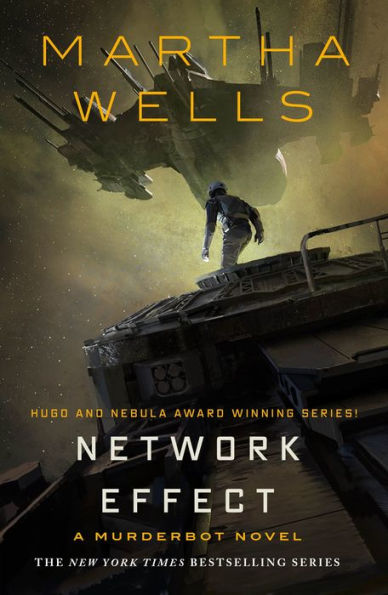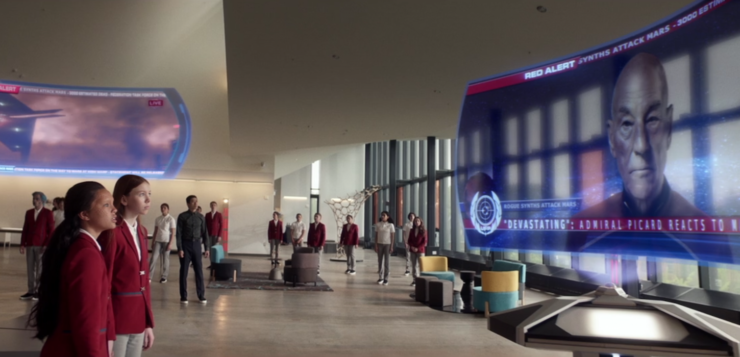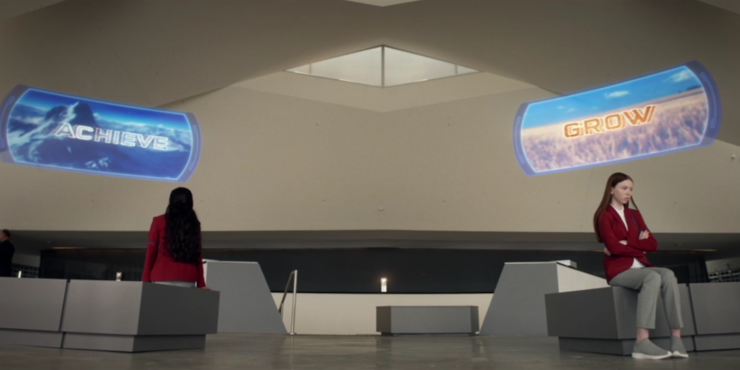Star Trek has never provided a particularly imaginative future. This isn’t really a problem, as such. Science fiction isn’t always—or even often—in the business of accurately predicting the future. And Star Trek in particular has always been more about commenting about the contemporary world than providing a possibly accurate lens to the future.
Because of this, Trek’s track record with schools is hilariously unimaginative, as we see in the last Short Treks episode of this batch, “Children of Mars.”
All the previous Short Treks that are bridging the schedule between the end of Discovery’s second season and the start of Picard’s first have hearkened to the past: use of Pike, Number One, and Spock across “Q & A,” “The Trouble with Edward,” and “Ask Not,” callbacks to Discovery’s second-season premiere in “The Girl Who Made the Stars” and to both the tardigrade in Discovery’s first season and the history of the original series in “Ephraim and Dot.”
“Children of Mars,” however, is a prelude to what’s to come. We’ve gotten hints from the trailers that some of the missing history between Star Trek Nemesis and Picard season one involves destruction on Mars, and this short piece is about that very destruction. It’s also only the second look we’ve had at the near future following Nemesis, the other being Spock witnessing the destruction of Romulus in the 2009 Star Trek. (In addition, the short “Calypso” and the Voyager episode “Living Witness” take place in the far future, relative to the 24th century, as will season three of Discovery.)
Our POV characters are two girls, one human (Lil), one alien (Kima), who attend the same school in San Francisco (we see the Golden Gate Bridge outside Lil’s window), and who both have parents who work on Mars. Kima’s mother works at Utopia Planitia, and we see them making funny faces at each other happily over subspace. Lil’s relationship with her father is more tense, as her father reluctantly tells her that he won’t be home “this year,” and she hangs up on him.
Here’s where the unimaginative part starts. The girls both live in apartments that have the exact same décor. I mean, I guess it might be student housing for the WSA (which I’m guessing stands for World Science Academy), but if that’s the case, why do they have to take a shuttle to school? Wouldn’t school housing be on campus?
In addition, WSA has a school uniform, which is—a choice, I guess. I dunno, in current times, school uniforms are primarily the purview of military and religious schools, and WSA doesn’t appear to be either. Also what do non-humanoid species wear? (Edited to add: several people have pointed out in the comments that my view on this is very U.S.-centric, and that around the world, school uniforms are more common. I stand corrected, though my question about non-humanoid species still applies…)
Buy the Book


Network Effect
The school itself has the students all sitting at desks and using little minicomputers. They’re transparent, so when one student sends a caricature of the teacher (unimaginatively called “Mrs. K”), the teacher sees it and gives two demerits to Kima, the girl who received it, rather than Lil.
Lil sent it to her by way of apology. Lil was so angry at her father’s note that she didn’t notice that she bumped Kima and knocked her schoolbag to the ground, making her miss the shuttle and come to school late. The caricature was meant to be a peace offering and apology, but it just got Kima in bigger trouble and Kima angrier at Lil. The tension between the two girls escalates, with Kima feeling picked on by Lil and Lil already angry at everyone and everything, so that it finally explodes into violence as Kima trips Lil in the library and then Lil jumps Kima at her locker and fisticuffs ensue.
That the kids aren’t pulled apart almost instantly is yet another thing that doesn’t make sense. The fight goes on far longer than it should be allowed to.
But then, as they’re sitting in the atrium awaiting discipline, there’s a major alert. An attack on Mars by “rogue synths” results in the destruction of both Utopia Planitia (where Kima’s mother works) and the orbital platform (where Lil’s father works). Their differences put aside, the girls clasp hands in the face of the tragedy.
As with “Ask Not,” this story—which is written by Picard co-creator Kirsten Beyer (who is, full disclosure, a friend of your humble reviewer), executive producer Alex Kurtzman, and Discovery co-executive producer Jenny Lumet—works mainly because of its short length. It’s pretty much completely predictable that the fact that both girls have parents working on Mars will be important to the story.
However, it most assuredly does work, due also to some excellent directing by Mark Pellington (who also helmed the much more claustrophobic “Q & A”), and superb performances by Ilamaria Ebrahim and Sadie Munroe as Kima and Lil, respectively. There is almost no dialogue in the short, with the action carried entirely by body language, facial expressions, and movement, while a haunting, elegiac cover of David Bowie’s “Heroes” plays on the soundtrack. Ebrahim and Munroe sell the unintended rivalry between the students magnificently, from Munroe’s apologetic look in the classroom to Ebrahim’s smoldering frustration at how her day has gone to shit, to both of their anger during the fistfight.
And then it all gets put into sharp relief when their respective worlds fall apart. As someone who was sitting in his living room watching two buildings in his hometown fall eighteen years and four months ago, I know the feeling that Kima and Lil and everyone at WSA has when they watch helplessly as ships strafe the surface of Mars.
Points also must go to Robert Verlaque—who previously played Saru’s father in the short “The Brightest Star“—for how he plays the Vulcan principal of WSA. Like everyone else, he has no dialogue, but he sells the character’s placidity, disappointment, and horror—all muted, as a proper Vulcan should be, but not completely suppressed, either.
The subtlety and skill of the performances overcome the simplicity of the plot, as does the very notion. I haven’t actually seen Picard yet, but I’m sure that it won’t present the destruction on Mars as anything other than an abstraction, a bad thing that happened in the past. Too often, dramatic fiction goes for the big event without really examining the human cost in any but the most general of terms.

“Children of Mars” puts a humanoid face on the destruction of Mars before we’ve even seen what impact it will have on Jean-Luc Picard in the future. (An image shows Admiral Picard’s response to the attack, which means it takes place some time in the interregnum between Nemesis, when he’s still a captain, and Picard season one, when he’s retired.) It’s not just an abstraction, it’s not just a vague tragedy, it’s an event that has consequences to at least two people in whose lives we’ve become invested in a very short time.
And it’s a nice teaser for that new show they’re debuting this month. I’m rather stunned that there wasn’t a preview at the end of it, to be honest…
In two weeks, we take a look at the premiere of Star Trek: Picard.
Keith R.A. DeCandido has been writing about pop culture for this site since 2011, discussing Star Trek in all its forms (including reviews of each episode of the various CBS All Access Star Trek productions as they’re released), as well as Doctor Who, Stargate, and various screen adaptations of comic books. His latest novels are Alien: Isolation, Mermaid Precinct, and A Furnace Sealed, plus his short fiction has appeared in Across the Universe, Footprints in the Stars, Brave New Girls: Adventures of Gals & Gizmos, Unearthed, Thrilling Adventure Yarns, and Release the Virgins!










